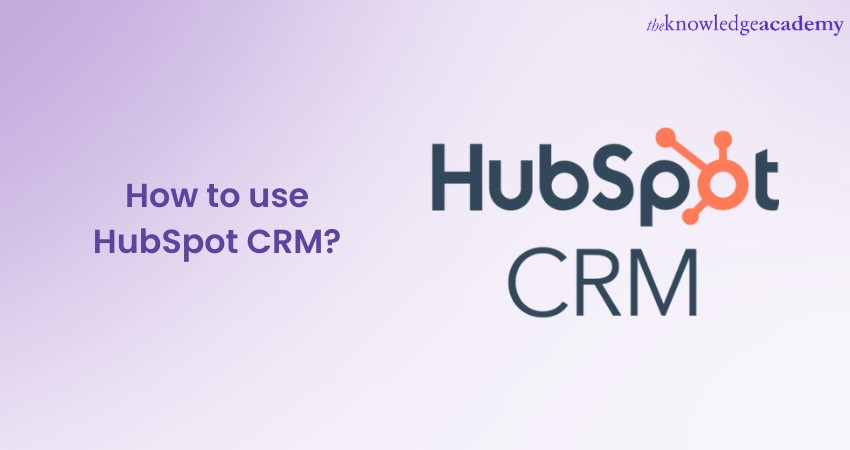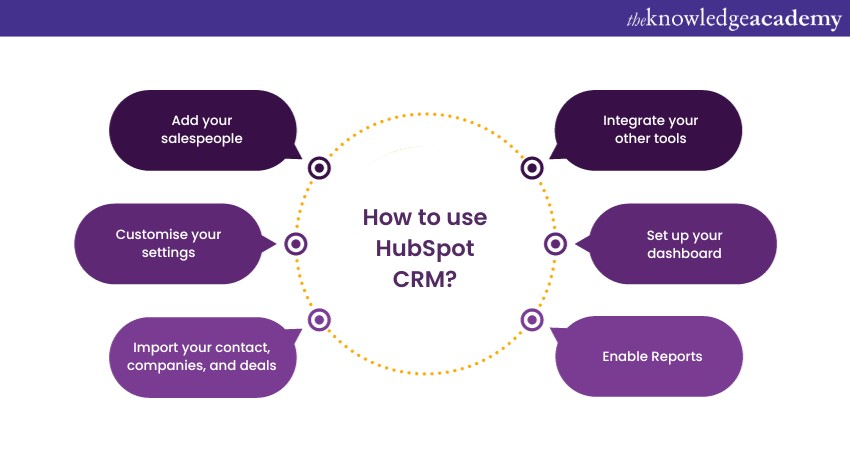We may not have the course you’re looking for. If you enquire or give us a call on +65 6929 8747 and speak to our training experts, we may still be able to help with your training requirements.
We ensure quality, budget-alignment, and timely delivery by our expert instructors.

In the ever-evolving business and customer relationship management landscape, having the right tools at your disposal can mean the difference between success and stagnation. HubSpot is a versatile and powerful platform that can help you revolutionise how you manage your business. In this blog, we'll take you through every aspect of How to Use HubSpot CRM, from adding your salespeople to enabling reports that can supercharge your sales and marketing strategies.
Table of Content
1) What is HubSpot CRM?
2) Why use HubSpot CRM?
3) How to use HubSpot CRM?
4) Pro tips on using HubSpot CRM
5) Conclusion
What is HubSpot CRM?
HubSpot CRM, or Customer Relationship Management, is a cloud-based software platform developed by HubSpot, a well-known inbound marketing and sales software company. HubSpot CRM is designed to help businesses manage and nurture customer relationships, streamline sales and marketing efforts, and improve overall customer data and interaction efficiency.
Why use HubSpot CRM?
There are several compelling reasons to use HubSpot CRM for your business. Here are some of the key Benefits of CRM and reasons why using HubSpot CRM can be advantageous:
1) User-friendly interface: HubSpot CRM offers an intuitive and easy-to-navigate interface, making it accessible for users of all levels of technical expertise. You don't need to be a CRM expert to get started and make the most of the platform.
2) Cost-effective: HubSpot CRM is available for free, making it an excellent choice for businesses looking to manage customer relationships without incurring significant costs. Small and medium-sized businesses can access powerful CRM tools without a substantial financial investment.
3) Integration capabilities: HubSpot CRM seamlessly integrates with various other HubSpot tools and third-party applications. This integration allows you to connect your CRM with your marketing, sales, and customer support efforts for a more cohesive approach to customer management.
4) Marketing automation: HubSpot CRM can be easily integrated with HubSpot's marketing automation tools, enabling you to automate marketing campaigns, lead nurturing, and personalised email marketing. This can save time and improve the efficiency of your marketing efforts.
5) Sales pipeline management: The platform allows you to set up and manage your sales pipeline, providing a clear view of your sales opportunities and helping your sales team stay organised and focused on closing deals.
6) Lead scoring: HubSpot CRM offers lead scoring, which helps you prioritise and focus on leads that are more likely to convert into customers. This can improve your sales team's efficiency and effectiveness.
7) Analytics and reporting: HubSpot CRM provides robust analytics and reporting tools that allow you to track the performance of your sales and marketing activities. You can generate reports and dashboards to gain insights into your customer data, informing your strategies and decision-making.
8) Customisation: The platform allows you to customise contact properties, deal stages, and other CRM elements to fit your business's unique needs and processes.
Ready to become a HubSpot CRM pro? Join our HubSpot CRM Training today and unleash the full potential of this powerful tool!
How to use HubSpot CRM?
Using HubSpot CRM effectively involves several key steps and strategies. Here's a comprehensive guide on How to Use HubSpot CRM:

Add your salespeople
Start by adding your sales team members to the CRM. To do this, you'll need to:
1) Log in to your HubSpot CRM account with your administrator credentials.
2) Access the "Users" or "Team" settings section.
3) Click "Add a User" and provide the necessary information for each salesperson, including their name, email address, and role.
4) Assign appropriate permissions, such as access to contacts, deals, and reporting features. Permissions can be customised based on the individual's role in your organisation.
Customise your settings
Customising your CRM settings allows you to adapt the platform to your specific business needs:
1) Go to the "Settings" or "Preferences" section in your HubSpot CRM.
2) Configure properties and fields: Customise the contact, company, and deal properties to align with the data you want to collect. You can add custom properties for unique information.
3) Set up pipelines: Define your sales stages and pipelines that reflect your unique sales processes. Each deal pipeline can be customised to match your business's sales workflow.
Import your contacts, companies, and deals
Importing data into your CRM ensures you have a well-populated database to work with:
1) Navigate to your CRM's "Import" or "Data" section.
2) Prepare your contact, company, and deal data in a spreadsheet, ensuring that columns match CRM properties.
3) Use the CRM's data import tools to correctly upload and map your data.
4) Verify that your data has been successfully imported and appears correctly in the CRM.
Integrate your other tools
Integrating HubSpot CRM with other tools streamlines your processes and data flow:
1) Explore the integrations section within your HubSpot account.
2) Connect your CRM with your website, email marketing platform, social media accounts, and other relevant tools.
3) Ensure data synchronisation between these tools and your CRM so information stays up to date across all platforms.
Set up your dashboard
Your CRM dashboard provides an at-a-glance view of essential data. Customising it will help you stay organised:
1) Access the dashboard settings or the "Customise Dashboard" option.
2) Add widgets: Choose widgets that display information you need, such as deals, contacts, tasks, or reports.
3) Arrange widgets: Organise the layout to prioritise what's most important for your sales team.
4) Configure date ranges and filters to view specific data relevant to your daily activities.
Enable reports
Enabling reports allows you to monitor and analyse your sales performance:
1) Go to your CRM's "Reports" or "Analytics" section.
2) Select or create reports: HubSpot CRM offers various pre-built reports, or you can build custom reports to track the metrics that matter most to your business.
3) Set up regular report notifications or automated report sharing with your team for transparency and accountability.
Unlock your full potential with our Microsoft Dynamics CRM Masterclass.
Pro tips on using HubSpot CRM
Here are some pro tips to help you get the most out of HubSpot CRM:
1) Customise your contact properties: Tailor your contact properties to capture the data that matters most to your business. Create custom properties to track unique information about your contacts.
2) Automate lead scoring: Integrate your email marketing platform with HubSpot CRM for a seamless email marketing experience. This lets you send personalised emails and track engagement directly within the CRM.
3) Leverage lead nurturing workflows: Create automated email workflows to nurture leads through the sales funnel. Deliver relevant content at the right time to move leads closer to conversion.
4) Integrate email marketing: Integrate your email marketing platform with HubSpot CRM for a seamless email marketing experience. This allows you to send personalised emails and track engagement directly within the CRM.
5) Set up meeting schedule: Use the meeting scheduling feature to allow leads and customers to book appointments with your sales team. This simplifies the scheduling process and increases convenience.
6) Use sales playbooks: Implement sales playbooks to guide your sales team through their interactions with leads and customers. Provide them with scripts, templates, and best practices to improve their sales conversations.
7) Monitor email open and click rates: Keep a close eye on email open and click rates. Use this data to follow up with engaged leads and tailor your email content to what resonates with your audience.
Take control of your sales strategies with our Oracle Sales CRM Masterclass. Elevate your expertise and transform your business today!
Conclusion
HubSpot CRM is a versatile and powerful tool that can transform the way you manage customer relationships and streamline your sales and marketing efforts. Whether you're a small business owner or part of a larger organisation, HubSpot CRM offers a range of features and functionalities to help you succeed in today's competitive business environment. By following the steps outlined in this How to Use HubSpot CRM blog and incorporating the pro tips, you can harness the full potential of HubSpot CRM to achieve your objectives of creative writing.
Want to stand out in your next HubSpot interview? Dive into our curated list of HubSpot Interview Questions and start practicing!
Frequently Asked Questions
What are the Other Resources and Offers Provided by The Knowledge Academy?

The Knowledge Academy takes global learning to new heights, offering over 3,000 online courses across 490+ locations in 190+ countries. This expansive reach ensures accessibility and convenience for learners worldwide.
Alongside our diverse Online Course Catalogue, encompassing 19 major categories, we go the extra mile by providing a plethora of free educational Online Resources like News updates, Blogs, videos, webinars, and interview questions. Tailoring learning experiences further, professionals can maximise value with customisable Course Bundles of TKA.
Upcoming Batches & Dates
Date







 Top Rated Course
Top Rated Course



 If you wish to make any changes to your course, please
If you wish to make any changes to your course, please


